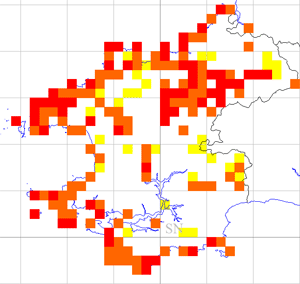Meadow Pipit - 2003-07
 Friday, May 11, 2012 at 9:25PM
Friday, May 11, 2012 at 9:25PM Meadow Pipits are ground-nesters, in open, rough grassland, heathland and moorland, where at an important host-species for the Cuckoo. In Pembrokeshire, Meadow Pipits can be found on rough grazing on the coastal slopes and headlands, on the islands, Ramsey, Skomer and Skokholm in particular, on lowland heathlands and on the slopes and tops of the Preseli Hills where they are the most numerous breeding passerine. Grasslands on the old, disused airfields such as Templeton, St Davids and Brawdy, which are extensively grazed, are also important for Meadow Pipits. Reseeded permanent pasture that is intensively grazed by dairy cattle or sheep is unsuitable for Meadow Pipits: the short swards provide insufficient cover for nesting, and disturbance from livestock grazed intensively is a hazard. Sheep are known to consume the eggs of Meadow Pipits.
Following the 1984-88 tetrad survey, it was noted that although still a common species, the Meadow Pipit had declined since, for example, Lockley’s review in 1949, in which he describes the Meadow Pipit as a common species. In between the two tetrad surveys, further changes occurred.
These figures suggest that changes in the distribution of Meadow Pipits have been both subtle and localised, although overall, they point to a decline in the breeding population. The distribution map shows that whilst there have been gains in some areas, there are now significant areas of Pembrokeshire away from the principal peninsulas, coastal fringes, and the Preseli Hills, where the Meadow Pipit is absent as a breeding species. Reasons for the overall decline and fragmentation of the breeding population are almost certainly linked to changes in agricultural practices, in particular farms moving out of more extensively mixed farming regimes into intensive dairy and sheep farming.
Following the 1984-88 tetrad survey, it was estimated that there were about 4,000 breeding pairs, based on an average density of 20 pairs per tetrad. Assuming that Meadow Pipits still occur at a similar density, then based on the number of tetrads where breeding was confirmed or probable during the 2003-07 tetrad survey, the breeding population is thought to be approximately 3,220 pairs.
Jane Hodges

Fieldwork 2003-07 (based on 490 tetrads)
Red = breeding confirmed = 66
Orange = breeding probable = 95
Yellow = breeding possible = 31
Total tetrads in which registered = 192 (39.2%)
 JEH,
JEH,  PBBA 2003-7 in
PBBA 2003-7 in  Meadow Pipit
Meadow Pipit 

Reader Comments